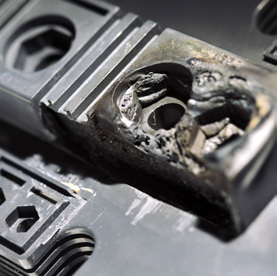Optimizing protective housings for sensitive electronics


Electrical devices are often integrated into plastic housing for protection against factors such as humidity, heat, or magnetic fields. How can these protective housings be made as robust as possible? This question is being investigated by Fraunhofer IMWS and the Präzisions-Plastic-Produkte GmbH company as part of the Design4LES research project. By June 2018, common housing materials will be characterized with regard to their behavior in electrical fields. The injection- molded test specimens, which are optimized for this purpose, will be inspected with regard to the microstructure after being subjected to extreme conditions. The intention is to examine the mechanisms of failure as precisely as possible. “Until now, even experts have not had a proper scientific understanding of these processes. The link between the microstructure – such as the pores or the adhesion between the glass fibers and the plastic – the processing technology, and the electrical failure behavior of thermoplastic materials in a damp en- vironment is largely unknown,” explains group leader Sandy Klengel from Fraunhofer IMWS. “That is why we are paying particular attention to the mechanisms that lead to loss of performance in thermoplastic housing materials when moisture gets in. We are investigating how the structure of the materials changes and how this affects the properties of the material used. That is an important question, particularly for applications within power electronics,” confirms Bianca Böttge, who leads the power electronics team within the group. The understanding gained allows manufacturers to optimize the formulation of the material and the production steps – such as the right figures for temperature, dwell times, and injection molding parameters. Finally, this allows the quality and performance of electronic housings to be increased significantly.
The project is funded by the European Regional Development Fund and the state of Saxony-Anhalt.
Last modified: